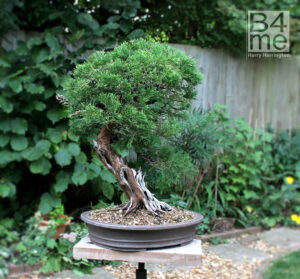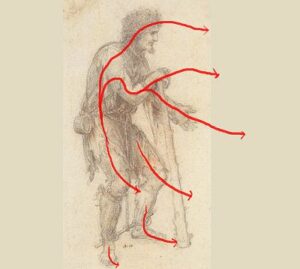There has been much debate in recent years as to the relationship between Bonsai and Art. Is the practice of Bonsai purely horticultural or does it have strong artistic aspects as well?
Many enthusiasts initially approach bonsai for it’s horticultural practices and it is only when they then attempt to style and form their trees, that the artistic and creative side of the practice comes into play.
There are in fact many basic artistic principles at play when we design our trees; or, at least there should be. Many of these principles are already provided for us in the commonly applied ‘Rules of Bonsai’.
Visual Movement, the subject of this article, is often found in ‘the Rules of Bonsai’ that determine the positioning of a bonsai in it’s pot and the relationship between objects in a Japanese 3-point display.
Visual Movement

This sketch by Leonardo da Vinci is known as ‘Masquerader in the Guise of a Prisoner’ and is taken from an old book of printed sketches by Da Vinci.
Each sketch in the book has been placed squarely on it’s page; possibly by the publisher or possibly by Da Vinci. This sketch is ideal for illustrating the purpose of, understanding, finding and using movement in Art, bonsai and photography.
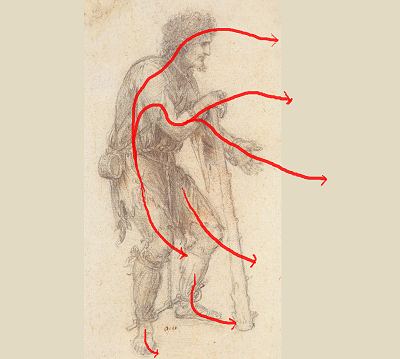
If the image is studied, key components can be found that show the direction of ‘energy’, the ‘flow’ of the picture or it’s movement.
Arguably the most important features are the subject’s face and hands, and to a lesser degree, his knees and feet. All are directed towards the right and therefore, the ‘movement’ of the picture could be said to be towards the right. (If one notices the cup hanging from the Masquerader’s belt, even this is open and facing towards the right).
Armed with this knowledge, the central figure can be placed in different positions in a larger frame, to better and worse effect.

Move the figure to the right hand side of the frame and something is now wrong with the composition. The flow and the movement of the figure is now cramped and the energy of the figure is lost. The empty space ‘behind’ the figure (on the left) looks unnecessary and awkward, almost wasted space.
Visual Movement, like the Golden Section is something we all ‘see’ and ‘recognise’ automatically on an almost subconscious level but we sometimes fail to acknowledge when we compose our own Art. Understanding movement in bonsai, photography or Art can help us exploit the subconscious of the human eye and enhance composition and the illusion of movement.
Another example using a photograph of a Juniper (digitally enhanced for the purpose of this article).

As with most people who take digital photographs, I like to crop my raw photographs to reduce file size and to improve the composition of my photos.
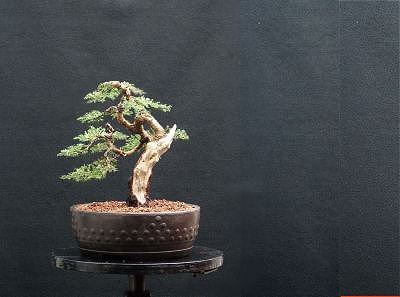
Though perhaps a little exaggerrated, I have seen images of bonsai, portraits and other photos with a strong focal point, cropped as badly as this. Why does this image look wrong to most people who study it, even those with no bonsai knowledge?
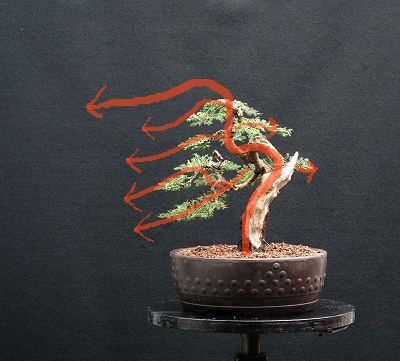
If the flow of direction of this bonsai is studied, even briefly, the visual movement is very strongly towards the left. Therefore the focal point (the bonsai) should be on the right hand side.
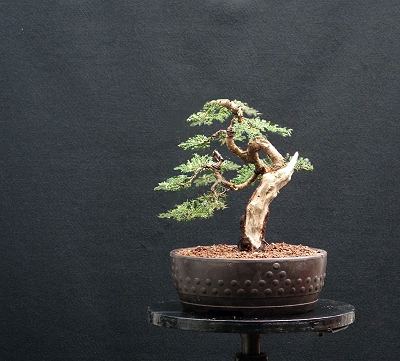
With the flow of movement of the tree found and the tree positioned in the composition correctly, the photograph looks correct. (Just compare the difference with the previous cropping).
At this point it is worth mentioning that some images don’t have pronounced movement left or right.
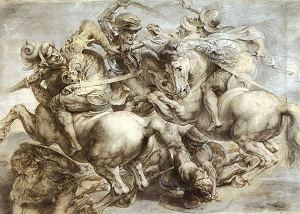
This image of Da Vinci’s ‘The Lost Battle of Anghiari’, is a good example of an image where the focal point is better placed centrally.
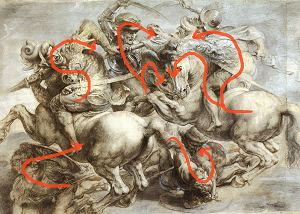
If the direction of movement of the main figures in this image are studied, their movement is inwards towards a central point. The figures on the right face left, the figures on the left, face right. All movement can be considerd to be inward facing.
The focal points of this image are already balanced and to balance the composition overall, the focal point is placed centrally.
Some focal points such as the one above all equally face outwards; again creating a focal point that is naturally balanced. Off-centre positioning of the focal point is therefore unnecessary.
A naturally balanced focal point can also be considered as being a focal point without movement.
Now the movement of a focal point and the repositioning of focal points according to their movement, have been established in this article. How can you apply movement to the focal point (the bonsai) yourself?
When styling a bonsai, the bonsai artist can decide which way he would like the movement of the tree to face and how much movement there should be. There are no real hard and fast rules when deciding how much movement can be added to a tree and indeed, in which direction the movement should be.
Essentially, the movement of the overall tree should imitate the movement of it’s trunk. While it is fine to have a strong, thick-trunked deciduous tree with a balanced canopy (like one you might see on a large meadow tree like an Oak) with little or no movement, a Juniper with a contorted trunk like that shown below, shouldn’t have foliage that is balanced, it should have movement one way or the other.

As explored previously in this article, the movement of this Juniper is towards the left. The majority of the foliage is on the left hand side of the trunk, facing towards the left hand side.

If I wished to make the tree more restful and balanced, I could reduce the foliage mass on the left and increase the foliage mass on the right.
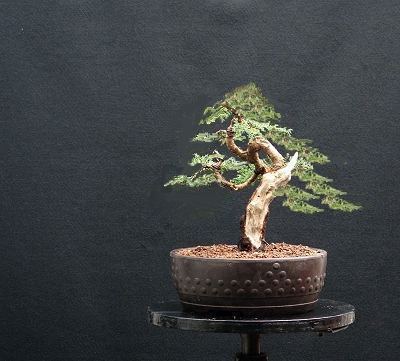
If I wanted the movement of the tree to be towards the right, I would need to place even greater emphasis on the foliage that is on the right hand side of the trunk and faces the right. Which of these three options is ‘best’ is subjective and lies in the hands of the artist.
Indicators of Movement
Particular to Bonsai For our purposes, an article on visual movement would not be complete without mentioning the visual strength of the apex and the first branch on a bonsai. In Bonsai, both the first branch and the apex are very strong indicators of movement (focal points); if the first branch of a bonsai (or sometimes the branch with the lowest foliage) faces left, it is very difficult to make the movement of the tree face right convincingly.
Notice the first branch in the last Juniper image and compare it to the previous images. For the tree with movement facing right to be convincing, the lowest foliage had to be moved to the right and the previous first branch on the left, had to be lifted and lightened. The apex of all bonsai has two sides, one steeper than the other; the steeper side indicates the direction of movement and nearly always reinforces the direction of the first branch.
Again, as such a strong indicator of movement, it is difficult (though not impossible) to convincingly show movement one way or the other if the first branch and the apex face in opposite directions.
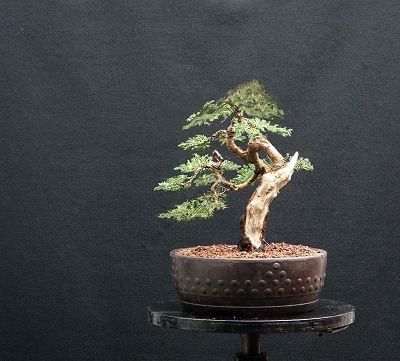
The above image has the Juniper with strong movement to the left, (including a strong first branch towards the left) but, has the right-facing apex taken from the previous image.
The conflict movement of the left first branch and right facing apex is very unsettling to the eye.
Why Take Any Notice of Movement?
Movement has to be acknowledged for a bonsai design to be successfully convincing; if a bonsai doesn’t quite look ‘right’, consider whether it’s movement is satisfying to the eye.
It must always be remembered that though the rules of Movement in Art and Design are known to few, all potential viewers of your work will subconsciously ‘see’ and acknowledge movement as being ‘right’ or ‘wrong’ in their eyes.
The Application of Art Principles in Bonsai Series: Part One: The Golden Section Part Three: Foreshortening


